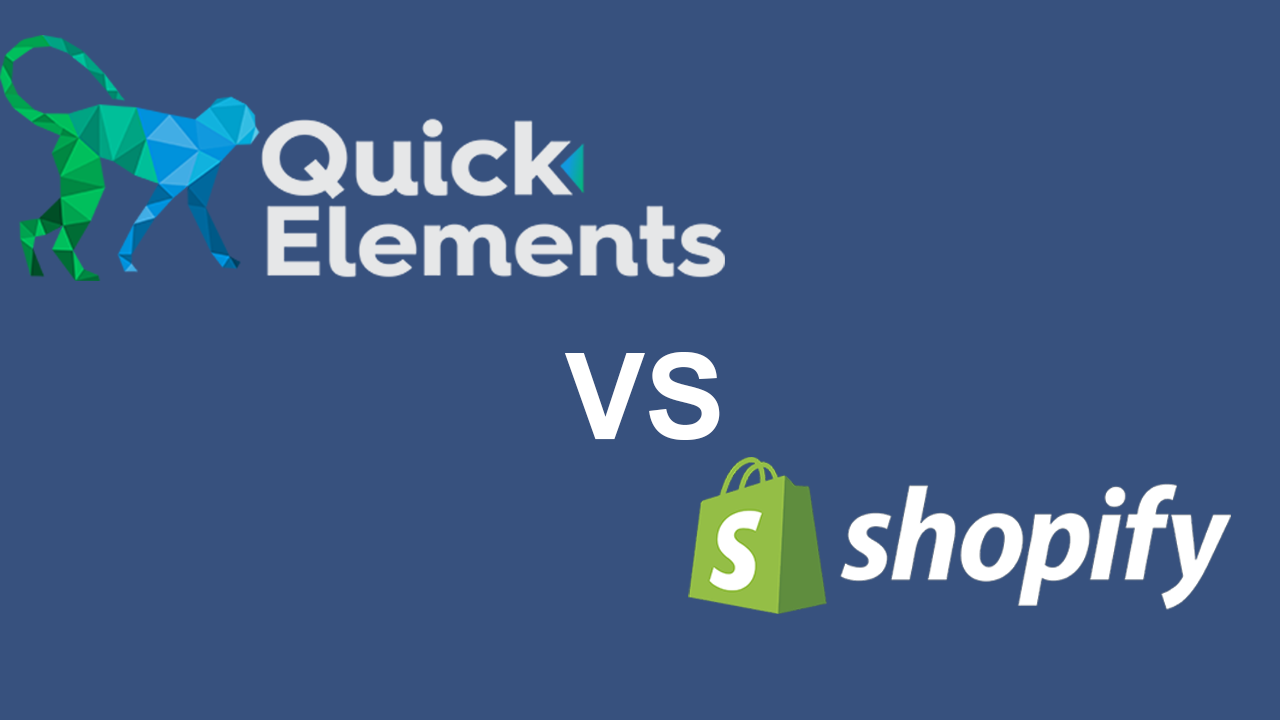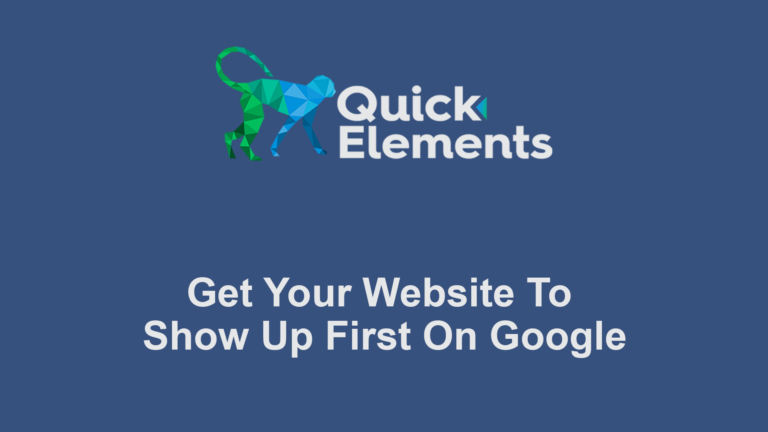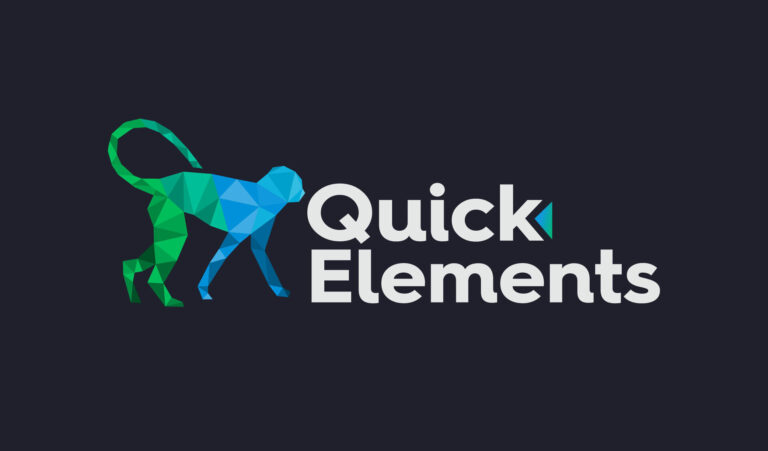In the ever-evolving world of e-commerce, selecting the ideal platform can be a pivotal decision for your business. It’s a choice that can significantly impact your online store’s performance, customization options, and overall success. Today, we’re diving deep into the comparison between Quick Elements vs Shopify, two prominent players in the e-commerce arena. Whether you’re an entrepreneur looking to launch your first online store or a seasoned e-commerce professional seeking the perfect platform for your next venture, this comprehensive guide will help you make an informed decision. Join us as we explore the key features, customization options, performance factors, and support resources of Quick Elements and Shopify, all with the goal of helping you find the best fit for your e-commerce needs.
Obviously we are a bit biased, but we’ve done our best to make sure we give Shopify a fair representation in this article.
Pricing and Cost
When it comes to choosing the right e-commerce platform for your online business, one of the most critical factors to consider is pricing. After all, you want to ensure that your chosen platform not only meets your business needs but also fits within your budget. In this section, we’ll compare the pricing and cost aspects of Quick Elements vs Shopify.
Quick Elements Pricing:
Quick Elements, offers a pricing advantage. Unlike Shopify, which is known for its free core software but can rack up costs with plugins, themes, and add-ons, Quick Elements provides a more streamlined and transparent pricing structure.
Quick Elements offers a straightforward subscription-based pricing model. Users can choose from various plans tailored to their specific needs. View the Quick Elements Pricing Page.

Shopify Pricing:
Shopify, on the other hand, also offers a range of pricing plans. However, it’s essential to note that while Shopify itself starts at $39 a month, most of its features come at an additional cost. These additional expenses can include transaction fees for third-party payment gateways, subscription costs for premium themes, and subscription fees for added functionality via the Shopify App Store. View the Shopify Pricing Page.

Transaction Fees for PayPal or Third-Party Payments:
One crucial aspect to consider when comparing these two e-commerce platforms is the transaction fees associated with payment processing. While both Shopify and Quick Elements offer various payment gateway options, Shopify imposes additional transaction fees when you use third-party payment gateways like PayPal or Stripe.
Shopify’s transaction fees can add up over time, especially for businesses with a high volume of sales. These fees are typically in addition to the processing fees charged by the payment gateway itself. On the other hand, Quick Elements doesn’t impose such transaction fees for using third-party payment processors. This can be a significant cost-saving advantage for businesses that prefer using established payment gateways like PayPal, Square, or Stripe to handle their transactions. Having multiple payment options available has been shown to drastically increase conversion rates.
Quick Elements vs Shopify – Email Pricing:
Another notable difference between Shopify and Quick Elements is how they handle email pricing. Email is a critical tool for e-commerce businesses to engage with their customers and drive sales. However, Shopify charges additional fees for using its built-in email features.
First, lets talk about personal email vs automated emails:
Personal email is used for one-to-one communication between individuals and is often tailored to specific recipients, while email marketing involves sending promotional or informational emails to a broader audience, utilizing automation and segmentation for targeted campaigns. Personal email is typically sent manually, while email marketing employs automation tools and is content-driven, aiming to achieve specific marketing goals or inform the recipient, such as an order confirmation or a shipping update.
Shopify does not offer personal email at all. You will need to use another service. Quick Elements prefers to allow their users to keep all of their tools in one place, so they offer personal email for free in some plans, or starting at $5 or $6 if it’s not included for free in your plan.
Shopify’s automated email tools, which include email campaigns, newsletters and transactional emails, come at an extra cost beyond your standard subscription fee. The pricing for email on Shopify can vary depending on the number of emails you send and the size of your email list. This additional expense can potentially increase your overall operational costs.
On the contrary, Quick Elements does not charge for transactional emails, and offers unlimited personal emails. Quick Elements only charges for mass marketing emails at a rate half that of Shopify ($1.00 per 1,000 emails vs $0.50 per 1,000 emails).
Ease of Use
When it comes to choosing an e-commerce platform for your business, one of the key factors to consider is the ease of use. This aspect plays a vital role in determining your overall experience while managing and operating your online store. In this section, we’ll explore how Quick Elements and Shopify compare in terms of user-friendliness.
Quick Elements Ease of Use:
Quick Elements stands out for its remarkable user-friendliness, providing a hassle-free experience for users of all technical levels.
- Interface: Quick Elements provides users with an intuitive and straightforward dashboard, ensuring that individuals with various levels of technical expertise can navigate it seamlessly. For more information on ease of use, you can view: How to use the Quick Elements Block Editor.
- Setup: Setting up an online store with Quick Elements is a hassle-free process. The platform offers step-by-step setup procedures and comprehensive tutorials, which help users get started swiftly. You are also assigned an account manager to help you build your site and answer any questions you might have. We touch more on this in the Customer Support section.
- Templates & Apps: Quick Elements offers a diverse range of pre-designed templates and themes that can be easily tailored to match your brand’s identity, all included free of charge. They have hundreds of templates fit for all different businesses & website categories. For users with coding skills, Quick Elements also provides the flexibility for code-level customization. Quick Elements also has a large selection of free apps available for you to install. Quick Elements does not currently charge for apps, so additional features are free and available instantly once you install them.

Shopify Ease of Use:
Shopify is also known for its user-friendly approach, catering to both newcomers and experienced e-commerce entrepreneurs.
- Interface: Shopify’s dashboard is designed to simplify the management of your online store. It features a drag-and-drop editor, allowing you to customize your store’s appearance effortlessly. While it doesn’t offer as much customization as Quick Elements, it is still able to be used to create amazing online stores.
- Setup: Shopify offers community based guidance throughout the setup process. While customer support is available, it mostly consists of pre-written answers and may be frustrating if you don’t ask your questions in a very specific way. You may also struggle to understand the broken English of the outsourced customer service. While you are usually able to understand what the customer service representative is saying, grammatical errors via text and heavy accents via phone support are common.
- Templates & Apps: Shopify also offers pre-designed templates and themes, however the cost will range from free to $400.00. There are currently 12 free themes on the Shopify marketplace and 145 paid themes. The average price of a Shopify theme is $250.00. The Shopify App Store boasts an extensive collection of apps and plugins that can enhance your store’s functionality. Integrating these apps into your store is typically a straightforward process, provided you are willing to shell out the extra cost for each one. These costs usually come in the form of an extra monthly subscription. While some Shopify plugins like “EU Cookie Bar” & “Product Reviews” are free, the most popular Shopify plugins cost between $10.00 and $200.00 per month each. Shopify does not offer customer support for third party apps, instead, you will rely on the third party companies.

In conclusion, both Quick Elements and Shopify prioritize user-friendliness, making them accessible options for establishing an online presence. Quick Elements streamlines the e-commerce journey with its intuitive interface and customization options, while Shopify offers a user-friendly dashboard and app integration as well, your choice between the two platforms will ultimately depend on your familiarity, your specific business requirements, and how much you are willing to spend.
Customization and Design
When building your online store, the ability to customize its appearance and design is crucial. Your e-commerce platform should offer the flexibility to create a unique and visually appealing storefront. In this section, we’ll delve into how Quick Elements compares to Shopify in terms of customization and design.
Quick Elements Customization and Design:
Quick Elements offers unparalleled design versatility and customization capabilities, providing an extensive array of options:
- Themes and Templates: Quick Elements offers a wide selection of free, pre-designed themes and templates that cater to various industries and aesthetics. These themes can be easily customized to match your brand’s identity and style.
- Code-Level Customization: For users with coding expertise, Quick Elements provides the freedom to customize every aspect of your website’s design. You can modify CSS, HTML, and JavaScript to achieve your desired look and functionality.
- Page Builder: Quick Elements offers a robust page builder, enabling users to create and modify layouts with ease. These tools offer drag-and-drop functionality, making it accessible for users with minimal technical knowledge.

Shopify Customization and Design:
Shopify offers a range of customization features, but it may not match the level of flexibility provided by Quick Elements:
- Themes: Shopify provides a selection of themes, both free and premium. While they are visually appealing, some may find these themes less customizable compared to Quick Elements. You may also have to pay for additional features only available in premium themes.
- Theme Editing: While Shopify allows users to customize themes to a certain extent, it may require coding knowledge for more in-depth changes. The level of customization may vary depending on the theme chosen.
- Page Builder: Shopify offers a page builder, enabling users to create and modify layouts. These tools offer drag-and-drop functionality, but do not include as many options as Quick Elements and may be more limited in the types of blocks you can choose from.
- App Integration: Shopify offers numerous design and customization apps in its App Store, which can extend its customization capabilities. However, this may involve additional costs.

Features
When it comes to selecting the right e-commerce platform for your business, the features it offers play a pivotal role in your decision-making process. In this section, we’ll dive into the comparison between Quick Elements and Shopify, focusing on key aspects such as the store builder, inventory management, shipping and fulfillment, SEO and marketing tools, analytics and reports, app store, email capabilities, and automation tools.
Store Builder:
Quick Elements offers a versatile store builder. It provides a user-friendly drag-and-drop interface, enabling users to create and customize their online stores effortlessly. It has powerful content management features and its store builder excels in flexibility and design customization.
Shopify, on the other hand, boasts an intuitive store builder specifically tailored for e-commerce. It simplifies the process of setting up an online store with its user-friendly interface. Shopify’s store builder is particularly advantageous for businesses seeking an e-commerce only solution, but may lack features if you want more than a store. It may be less intuitive to add additional features like an advanced blog to your site, for example, as Shopify is specifically designed for e-commerce.
Inventory Management:
Quick Elements integrates robust inventory management tools, allowing businesses to efficiently track product availability, manage variants, and receive low-stock notifications. This functionality seamlessly blends with its content management capabilities, providing a holistic approach to e-commerce.
Shopify offers comprehensive inventory management features as well. Users can monitor inventory levels and do inventory tracking. Shopify’s inventory management can be extended with the use of paid add-ons.
SEO and Marketing Tools:
Quick Elements inherits strong SEO foundations, making it an excellent choice for businesses seeking solid search engine optimization capabilities. Users can optimize content, utilize SEO plugins, and implement on-page SEO strategies.
Shopify offers basic built-in SEO features and tools, allowing users to optimize their online stores for search engines. Additionally, Shopify offers paid marketing tools for additional fees.
Analytics and Reports:
Quick Elements provides users with access to a range of analytics and reporting options. This allows businesses to track website traffic, monitor user behavior, and generate custom reports for data-driven decision-making. Quick Elements uses Google Analytics to track user engagement.
Shopify offers analytics and reporting features within its platform. You can also install Google Analytics on your Shopify website.
App Store:
Quick Elements leverages an extensive plugin ecosystem. Users can access a multitude of plugins and extensions, including marketing tools, e-commerce features, and automation solutions, all for free.
Shopify features its App Store, offering a wide selection of apps and plugins that extend its functionality. This curated marketplace allows users to enhance their stores with various tools, from email marketing to inventory management. The Shopify App Store offers both free and paid apps.
Email:
Quick Elements offers a built in email marketing platform to manage email campaigns effectively. Users can leverage its power to create and send engaging newsletters.
Shopify also offers basic email marketing capabilities, allowing users to design and send email campaigns directly within the platform.
Automation Tools:
Quick Elements users can implement automation tools and workflows. These tools enable businesses to streamline processes, such as order fulfillment, spreadsheet and database management, automatic emails, and more.
Shopify does not offer very many automation features. Shopify does not allow you to build your own automation workflows.

Quick Elements vs Shopify: Performance and Speed
When it comes to running an online store, the performance and speed of your e-commerce platform are crucial factors. A fast-loading and responsive website not only enhances the user experience but also impacts your search engine rankings. In this section, we’ll evaluate the performance and speed of Quick Elements and Shopify, two popular e-commerce platforms.
Website Loading Speed:
Website loading speed is a critical aspect of user experience and search engine optimization. Quick Elements benefits from a vast ecosystem of optimization techniques and tools. Quick Elements implements various performance-enhancing strategies, such as caching, image optimization, and content delivery networks (CDNs), to ensure fast loading times.
Shopify, as a hosted solution, is optimized for speed and reliability. Its infrastructure is designed to handle high volumes of traffic efficiently.
On average, Quick Elements websites will load faster and score higher Google Pagespeed Scores, but both Shopify and Quick Elements can have fast website loading speeds if optimized correctly.
Mobile Responsiveness:
Mobile shopping has become increasingly popular, making mobile responsiveness a crucial factor. Both Quick Elements and Shopify offer responsive design themes that adapt to various screen sizes and devices. However, the extent of responsiveness may vary depending on the specific theme you choose. Quick Elements themes are designed from the ground up to work well on both mobile and desktop.
Shopify’s mobile responsiveness will depend on the theme you choose. Some will look better on desktop, some will look better on mobile, and some will look good on both.
In conclusion, both Quick Elements and Shopify offer competitive performance and speed, but there are key differences. Quick Elements, with its flexibility and optimization options, can achieve excellent performance with the right setup. Shopify also offers a hassle-free and sufficiently fast experience for most users.
SEO and Marketing Tools
In the digital realm, visibility is paramount. To succeed in the competitive world of e-commerce, having robust SEO (Search Engine Optimization) and marketing tools at your disposal is essential. In this section, we’ll delve into the comparison between Quick Elements and Shopify in terms of their SEO and marketing toolsets.
SEO Features:
SEO is crucial for attracting organic traffic to your online store. Quick Elements inherits the strong SEO foundation. Users can optimize their website for search engines by utilizing SEO plugins and techniques, optimizing content, and managing metadata. Users can edit meta titles and descriptions, customize URLs, and optimize images for better search engine rankings. The Quick Elements platform codebase is specifically designed with SEO in mind and all best practices are used to increase your chance of ranking in search.
Shopify provides basic SEO tools. Users can also edit meta titles and descriptions, customize URLs, and optimize images. There are also additional paid SEO apps you can install to enhance your SEO.
Content Marketing:
Content marketing is a powerful strategy to engage and inform your audience. Quick Elements excels in content management, making it an ideal platform for content-driven marketing. Users can create and publish blog posts, articles, and other content types with ease. Additionally, Quick Elements supports a wide range of content marketing plugins, allowing users to enhance their content strategies.
Shopify also offers a simple blogging feature for content marketing. While it may not be as robust as Quick Elements in terms of content creation and management, it provides the basic necessary tools for businesses to maintain a simple blog and share content with their audience.
Marketing Automation:
Marketing automation streamlines repetitive tasks and enhances customer engagement. Quick Elements users can implement automation tools and workflows. These tools enable businesses to automate processes such as order fulfillment, spreadsheet and database management, automatic emails, lead nurturing, and more.
Shopify does not offer automation workflow management.
Social Media Integration:
Social media plays a significant role in e-commerce marketing. Both Quick Elements and Shopify offer social media integration options. Users can connect their online stores to social media platforms, share products, and leverage social media marketing to drive traffic and sales.
[Image: Quick Elements social media integration vs Shopify social media integration]
In summary, both Quick Elements and Shopify provide a range of SEO and marketing tools to help businesses succeed online. Quick Elements, with its content management prowess, offers a solid foundation for content marketing and SEO. Shopify, on the other hand, offers simple SEO & marketing tools that are usually good enough for new businesses.
Customer Support
In the world of e-commerce, having access to reliable customer support can be invaluable. When issues arise or questions need answers, knowing that help is readily available can make a significant difference. In this section, we’ll compare Quick Elements and Shopify in terms of their customer support resources.
Customer Support:
Quick Elements offers amazing customer support. Each user is given a dedicated account manager who is there to answer questions and provide support for you. You can contact support via email, phone, text, or live chat. All customer support representatives are based in the USA.
Shopify provides customer support through various channels, including live chat, email, and phone support. Shopify outsources most of it’s customer support to off-shore countries for cost saving measures.
Documentation and Resources:
Both Quick Elements and Shopify offer extensive documentation and resources to help users navigate their platforms. Quick Elements users can access vast library of tutorials and guides, covering a wide range of topics from website setup to advanced customization. Users can find step-by-step guides, video tutorials, and FAQs to assist them in setting up and managing their online stores.
Shopify provides comprehensive documentation and a knowledge base that covers various aspects of using the platform. There are tons of community made videos and tutorials, guides, as well as paid courses and help offered on various blogs and social media platforms.
Conclusion
In the dynamic world of e-commerce, choosing the right platform is paramount to your business’s success. Quick Elements and Shopify are two prominent options that offer distinct advantages depending on your unique needs and preferences.
Quick Elements provides flexibility, customization, and a vast library of plugins. It’s an excellent choice for those who value creative control. Quick Elements excels in content management, SEO optimization, and content-driven marketing, making it a solid choice for businesses that prioritize these aspects.
Shopify, a dedicated e-commerce platform, offers a streamlined solution with lots of additional paid apps to add features to your site. It excels in simplicity and reliability. Shopify simplifies the e-commerce journey for those that just want to build an online store, and nothing more.
When making your decision, consider your specific business requirements, such as customization needs, performance expectations, and preferred customer support access. Both platforms have their strengths, and the choice between Quick Elements and Shopify ultimately hinges on which features align best with your e-commerce goals.
At the end of the day, whether you choose Quick Elements or Shopify, you’re taking a significant step towards establishing a successful online presence. Each platform offers advantages, so make your choice wisely, and watch your e-commerce venture thrive in the digital landscape.

 Websites
Websites
 CRM
CRM
 Marketing
Marketing
 Professional Email
Professional Email
 Documents & Backups
Documents & Backups
 Email Marketing
Email Marketing


 About Quick Elements
About Quick Elements




